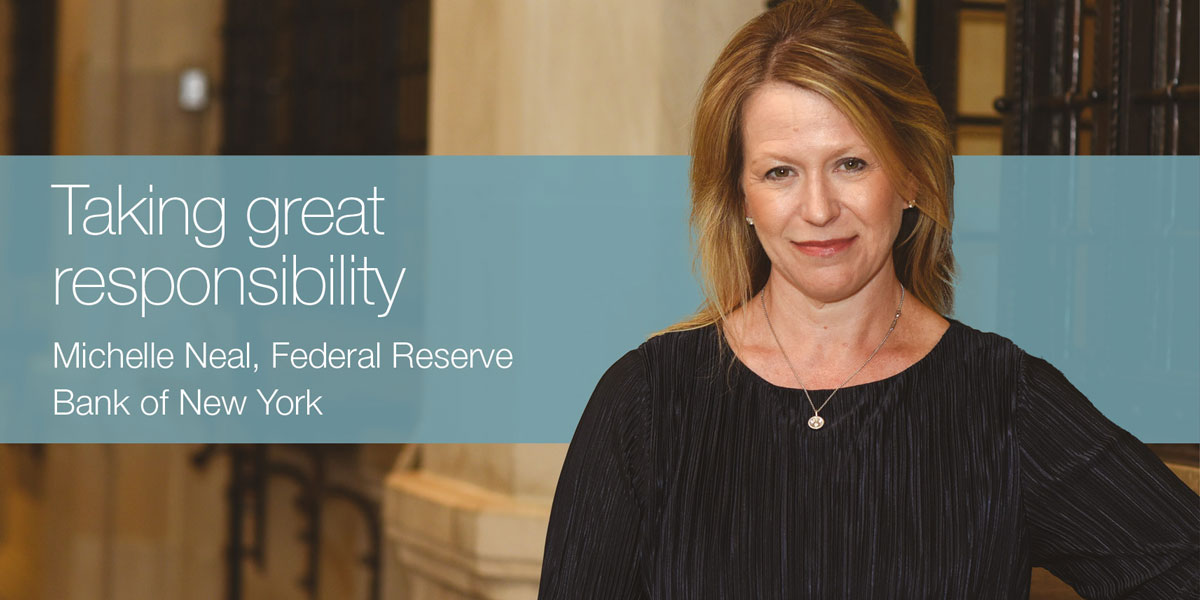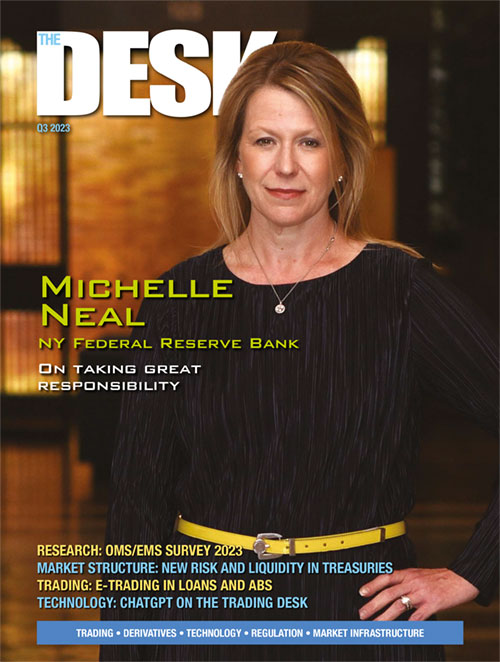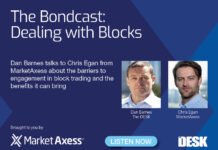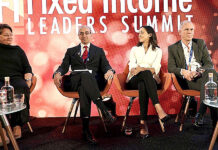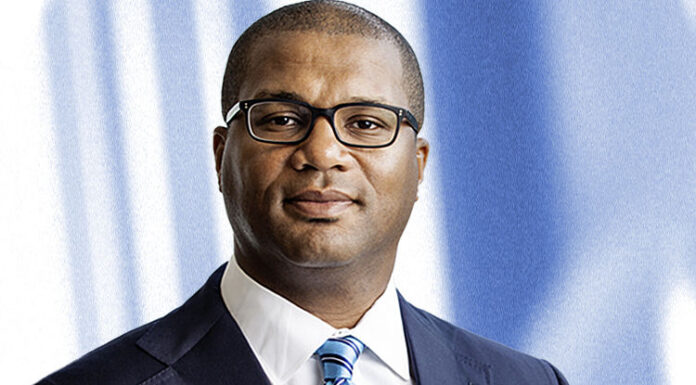Having managed the market divisions at several top-tier financial institutions, Michelle Neal is now responsible for supporting the most significant fixed income market in the world.
Having managed the market divisions at several top-tier financial institutions, Michelle Neal is now responsible for supporting the most significant fixed income market in the world. How would you describe your current role, in comparison with working in the markets as you’ve done most of your career?
I feel that a lot of the work that I’ve had the opportunity to take part in during my career has been an honour. My current role is really the pinnacle of working in markets. My role is head of the Markets Group at the Federal Reserve Bank in New York. There are 12 different Reserve Banks across the US and some functions are syndicated across different reserve banks for the districts that they serve. But there’s only one Markets Group for the Federal Reserve System, run by the New York Fed. It’s a multi-faceted group of functions. I would describe them broadly as infrastructure heavy and operationally sensitive. The Markets Group provides multiple services, including the implementation of monetary policy through open market operations. We monitor and analyse global financial markets. We provide capital markets services to the US Treasury through primary issuance of US Treasury securities. And we serve also as the lender of last resort in the New York Fed’s region, which includes many of the world’s globally systemic financial institutions. Any discount window lending that happens for those large firms happens here.
We have a team that also provides financial services, including execution, settlement, clearing, collateral management, custody, and payments, like a full service bank would, but we provide that service to foreign central banks and international official sector organisations such as multilateral development banks. Then we have an international policy team that manages engagements with other foreign central banks and also analyses macro trends and country risk. That team also organises seminars and events for other central banks and other organisations around the world. Lastly, our operations span both domestic and international markets, and our international reach is broad. It includes swap lines and repo operations with other central banks. And then of course, we operate many of the emergency facilities that were provided during the global financial crisis, again during the pandemic and 2020, and last March, during the less widespread banking challenges.
The main comparison of my current role to other roles that I’ve held is that the Markets Group, New York Fed, and the broader Federal Reserve System are mission driven. My other roles, while having some similar characteristics, really have been focused on building commercial franchise capabilities and delivering financial results. But across my career, I’ve always been a person who’s been trusted and tasked with delivering on strategic objectives that include future proofing and commercialising businesses around evolving emerging regulation and market structure. In that sense there are some commonalities, but the objectives and underlying mission are fundamentally different.
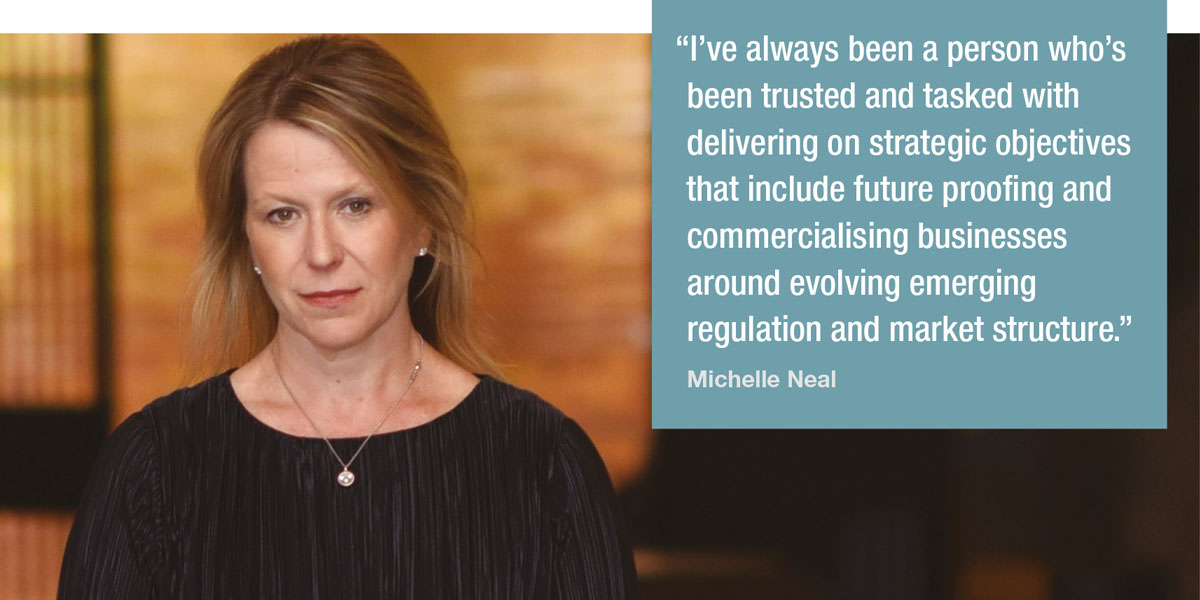
What are your targets over the short term, and longer term?
On a short term basis, we have to flawlessly manage the day-to-day activities of the New York Fed’s Open Markets Trading Desk’s activities, as well as all the functions across the Markets Group that I mentioned above. We have the objectives of supporting career development for staff, integrating new staff, and doing all of those things while being responsive to supporting the Federal Open Market Committee and its monetary policy objectives and managing the Fed’s balance sheet. Those short term goals are really our bread and butter, day-to-day table stakes activities. Longer term, we are evolving the business architecture of the Markets Group, to ensure that it’s fit for purpose across multiple dimensions from structure, talent, culture, and everything that’s human capital related, as well as evolving our platforms, processes and operations to ensure that we really are prepared for the future.
Which of the experiences do you find most valuable your current role?
I love the New York Fed’s mission-driven focus, and the significant commitment to contributing to serving the American people, and ensuring a strong US economy and a stable financial system for all segments of society. The experience that I’m getting from doing that is really just amazing. And it’s really humbling to work alongside the New York Fed’s Executive Committee, as well as my own management team and the Markets Group, to carry out that mission. The New York Fed is at the centre of some of the most critical financial and public policy issues, so we’re constantly innovating and working to stay ahead of future needs. Bringing my experiences and applying them here is very rewarding.
Where do you see risk existing in your current role and how do you manage that?
We manage risk across multiple dimensions. This includes looking at operational risk, credit risk, and reputational risk, which is obviously a big consideration. For the things that we do, we might look at some of these risk categories with a slightly different lens than other institutions would, but there are many similarities. We have a management team within the Markets Group that is mutually accountable for the risks across the Group. We work to really enhance that mutual accountability of the management team for our risk profile and we work in the three lines of defence format, with business being the first line, and our partners in risk and audit, managing the second and third lines. That’s a model that I really believe in.
What is the shape and the size of the Markets team that you currently manage?
It’s one of the larger Groups in the New York Fed, split across functions and we have a centralised services team that supports activities common to the broader Group for efficiency, leverage, and common services. We also partner with other Groups across the New York Fed, related to People & Engagement, Risk, Finance, Legal, and Operations & Resiliency. That collectively helps us to deliver on our mission. I’m a true believer in the sum of the parts being greater than the individual pieces. Although those functions may sound distinct, there’s a lot of integration touchpoints amongst them. Working together across those functions is really important.
Are the skills that your teams need changing, and how are you supporting their development?
We need people with skills that can support activities such as trading, analysis, operational work, and we also need strong product and technology professionals that can be solution-orientated as we evolve our platform and continue to evolve the business on an ongoing basis. We need risk-orientated professionals that support us on this journey. I think STEM-based skills are a real advantage but the discipline of learning and studying in various settings and majors when you’re starting out in your career can be very relevant. We can provide unparalleled opportunities for a broad range of skill sets, given the breadth of our activities, and also the front-to-back nature of supporting the platform. I really believe in thinking about the business on a front-to-back basis and I think it’s really important that people have that holistic perspective of how things work, via the cycle of activities and transactions, because that provides strong foundations for career growth in the future.
How would you describe your leadership style?
I’m honest, and straightforward, reliable and trustworthy. I am an advocate for my business and the people in it. I think anybody who knows me would say that I am very consistent. I also operate as a member of the New York Fed Executive Committee so it’s important not only to represent my own business, but also to underscore the mission of the New York Fed more broadly, and its mission, vision, values and strategy, to ensure that all staff in the Markets Group, understand how they’re connected to it. Followership is about inspiring peers and other colleagues on the importance of a strategy and vision, and eliciting the support to effectively execute in all types of business conditions. I believe in the notion of investing in foundational capabilities, and ensuring that things are genuinely good from the inside out. It’s really important to how I approach things.
Do you see the need for leadership in diversity or does that develop organically?
It absolutely does require leadership. You hope that the leadership leads to organic development and strengthening foundations. Leaders play a key role in fostering a diverse workforce and inclusive work environment. Here at the New York Fed, diversity and inclusion are major priorities for us. The values are really essential to fulfilling the New York Fed’s mission to make the US economy stronger, and the financial system more stable for all segments of society. From a workforce perspective, recruiting and retaining diverse talent at all levels are essential. This has been true in multiple settings that I’ve worked. Diverse perspectives really yield more creative approaches, and tangible outcomes for everybody on the team and the organisation. From the perspective of the specific work that we do, we also work to support diversity in our counterparties and procurement efforts. For example, while we were operating some of the Covid-related emergency facilities, we made a deliberate effort to encourage minority, women and veteran-owned firms to assist us with these programmes. We added about 12 diverse firms to serve as counterparties or transaction agents, and we awarded a cash management mandate during that period to a majority women-owned firm following a highly competitive procurement process. Separately, we have also listened to market participants about their efforts to promote diversity and inclusion in capital markets activities more broadly.
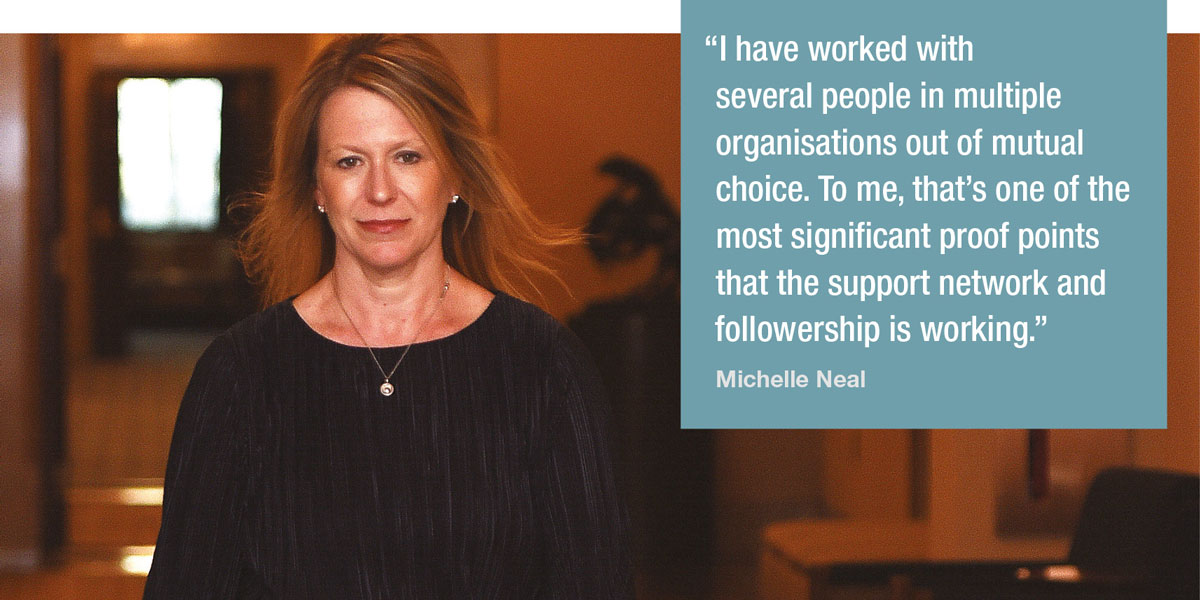
Looking at your career, which achievements do you think have been most worthy of note?
In all cases, roles that I have been responsible for have been an honour to serve in, and have either been created out of the need to do something transformational, or needed to be done differently than how they were done in the past. I’ve never ever sat down and cranked the handle on the business that the person before me was responsible for in the same way. Frankly, I’m not even sure I would know how to do that. The thing that has always been a challenge, is how to ensure that the business you’re responsible for – or the broader business that you operate in – is fit for modern competition, modern regulation and modern market structure. That normally requires change. You have to support that existing franchise at the same time, to live in your house while you renovate it, and neither move too fast nor too slow. Each scenario is a little bit different but the recipe has similar ingredients.
Who have you supported in your career and who has supported you?
My supporters have not only been superiors, but also peers, and people at all levels in the businesses that I’ve been responsible for. You can learn so much from your peers and your team. I’m a big believer in reverse mentoring.
People often think that sponsorship or mentorship is something that endures over a long period of time, but sometimes it’s also fleeting. You have to spot it in the moment and grasp it. That’s a message I give to people when they’re considering how to find mentors and sponsors. I really take pride and time in supporting and sponsoring people as well. Although there’s a limit to how much you can do one-to-one, I also like to do that through resource networks and group settings.
I have worked with several people in multiple organisations out of mutual choice. To me, that’s one of the most significant proof points that the support network and followership is working.
What do you do outside of work?
I have an amazing husband and two kids, Harry and Amy. I’ve got two Schnauzers, Boris and Lottie. Outside of work for me is 100% about them, and pursuits that we can enjoy together. Outside of my work, school activity and sports, it doesn’t leave time for a lot. Getting some skiing in and visiting beach at some point in the year. Sunday dinners are very precious to me. It doesn’t sound super exciting, but that’s about what I have time for.
In terms of transferable skills, what do you think are the most useful that you’ve learned?
A genuine passion for markets and effecting change. You have to be passionate about what you do with a genuine orientation towards wanting to progress and get ahead. Strategy development, and demonstrating that you can execute on that strategy. If I say we’re going to do something and we do it, and we can show the outcomes, then we can continue to build credibility by repeating that cycle, and demonstrating the results. Domain expertise really helps you to understand what works and what doesn’t. Market structure and technology would be really important ones for me. I work shoulder-to-shoulder with our teams on those issues. Networking and relationship building can be underestimated, but are very important.
What’s your perspective on the significance of the Treasury market and the work that the Fed has been doing to support its resilience?
The US Treasury market is the deepest and most liquid securities market in the world, and critical to the functioning of the broader financial system. The Treasury market serves as the global benchmark for other financial markets. It’s the market where monetary policy is executed, and where the Treasury Department finances the Federal Government. Given its importance, the New York Fed has a long-standing investment in supporting the resiliency of the Treasury market. Many of our activities in the Markets Group are about that. The New York Fed contributes to the Interagency Working Group (IAWG) for Treasury market surveillance that consists of staff from the New York Fed, the Federal Reserve Board, the US Treasury, the SEC and the CFTC. Since 2015, the New York Fed has hosted a flagship conference in the US Treasury market tied to that work. It’s co-sponsored by those other IAWG agencies. We bring together market practitioners, academics, members of the official sector to discuss emerging Treasury markets, and issues of the Treasury markets and advanced initiatives to promote resilience.
We’ve also made recent progress on the research put out by the New York Fed on topics that contribute to Treasury market resilience. For example, last year, staff from the New York Fed, the Federal Reserve Board and US Treasury put out a New York Fed staff report on the topic of all-to-all trading in the US Treasury market. This is an emerging area in the Treasury market that could introduce new methods of trading and increase resiliency of the market.
What are the key issues the Fed is prioritising related to the US Treasury market and its resilience?
The first I would mention is data and transparency. There have been some helpful steps toward increased data and transparency in the market. FINRA has begun releasing aggregate TRACE transaction data daily. The US Treasury has announced plans to release transaction data for on-the-run nominal coupons and the Office of Financial Research (OFR) has conducted a pilot for data collection on non-centrally cleared bilateral repo, and has proposed an ongoing collection of this data. Even with this progress, gaps in data and transparency remain. Earlier this year, the Treasury Markets Practices Group (TMPG), which I sponsor for the New York Fed, put out a white paper on data availability and transparency in the US Treasury market that identified several gaps, particularly in the dealer-to-client cash market and the repo market. Given the importance of the Treasury market, both the official sector and the public need to have improved access to Treasury market data, and that’s something we’re focused on.
Another area is the uncleared bilateral repo market. This is an area where both the official sector and the market participants have very little visibility, and where margining and settlement practices are largely bespoke and opaque. This was shown by the OFR bilateral repo pilot data collection recently, and this is an area where further study and understanding is obviously still needed. The TMPG is studying risk management in this market as one of its key 2023 priorities. I’m working in partnership with other groups to do that.
What’s your view of the potential that distributed ledger technology (DLT) offers?
There are definitely benefits. The value of DLT is really use-case specific. It’s not the right technical choice for all use cases, but may offer advantages over alternatives in some areas. For example, DLT can increase operational efficiency across the asset lifecycle. Implementations such as issuance, trading, execution, clearing and settlement are all use cases where I see some applicability. DLT allows for atomic settlement. It reduces the time between trade and settlement, reducing or even virtually eliminating the potential for settlement fails and related counterparty risks. Atomic settlement in that regard also allows for higher velocity trading and more efficient use of capital. Work at the New York Innovation Center has demonstrated this through its work on Project Cedar. DLT has the potential to improve data management and access for counterparties. That single source of truth, improving privacy, management, and market interest and compressing settlement times.
There’s also a couple of counterpoints, that are important to bear in mind. The effects on capital efficiency are mixed. Shortening settlement cycles using tokenised securities, for example, may reduce margin that a clearinghouse needs to collect from its members. Arguably, on the other hand, a compressed settlement window could reduce the benefits of netting and multilateral margining which is another important consideration for market participants that could be less efficient. There are, generally speaking, trade-offs that will depend on the specific architecture of any DLT solution.
What do you see the role of the Fed being, in terms of supporting innovation more broadly?
This is very close to my heart. Innovations occur in the financial system with implications for our core missions, including execution of monetary policy, monitoring financial stability, operating critical payment infrastructure, and supervising banks and designated market utilities. It is our job to understand innovations where it is appropriate for us to do so, and adapt so that we can continue to fulfil our mission. We hear from and listen to market participants as they continue to invest in innovation efforts, including those related to DLT and tokenisation, but not exclusively those.
A key example is the New York Innovation Center. Typically, there we conduct research ourselves and in collaboration with the industry. Project Cedar on cross-border payments is one of the widely-known pieces of work that the group has undertaken, and it really builds on our competencies, allowing us to engage and influence industry developments in ways that take account of our missions effectively. It connects us to work with other major central banks and helps us promote the innovations that are consistent with a well-functioning and resilient financial system. We are also interested in ensuring that the DLT innovations impacting payment infrastructure consider reliability, safety, and resiliency. We have interests in knock-on effects, such as impacts to the liquidity needs of banks and other market participants. And of course, we’re always looking at our own systems to make sure that they are well positioned to align with future needs.
©Markets Media Europe 2023
©Markets Media Europe 2025


